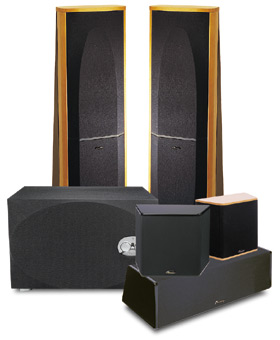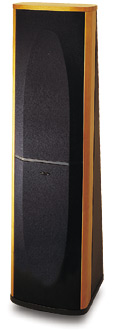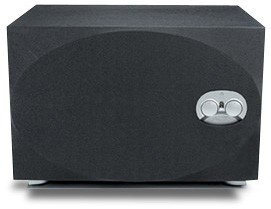
|

Mirage Speakers
OM-9 / OM-C2 / OM-R2 / LF-150
Home-Theater Speaker System

|
|
|
 |

Description Model:
OM-9 speakers
Price: $1400 USD per pair
Dimensions: 43.75"H x 11.56"W x 12.175"D
Weight: 55 pounds each
Model: OM-2 center-channel
Price: $750 USD
Dimensions: 7.375"H x 24.625"W x 12.125"D
Weight: 30 pounds
Model: OM-R2 surrounds
Price: $600 USD per pair
Dimensions: 9.75"H x 11.75"W x 5.25"D
Weight: 12 pounds each
Model: LF-150 subwoofer
Price: $500 USD
Dimensions: 19.75"H x 12.5"W x 14.125"D
Weight: 45 pounds
System price: $3250 USD
Warranty: Five years on speakers, one year
on subwoofer |

Features
- Omnipolar technology
- 1" Pure Titanium Hybrid (PTH) tweeters
- Polypropylene cone woofers
- Live Soundstage Crossovers (OM-9, OM-C2, OM-R2)
- 10" Titanium Deposit Polypropylene Hybrid woofer
(LF-150)
- 150W continuous, 600W peak MOSFET amplifier (LF-150)
- Adjustable crossover (40Hz to 120Hz) and phase switch
(LF-150)
- Cherry or high-gloss black finish (OM-9 and OM-C2)
- Cherry, high-gloss black, or white finish (OM-R2)
- Black, brushed-metal laminate finish (LF-150)
|
The home-theater speaker system under review here features
the OM-9, the least-expensive tower speaker in the OM series, grouped with the OM-C2
center-channel, the OM-R2 surround, and the LF-150 subwoofer. The system can be purchased
with larger mains, namely the OM-7 and the OM-5 towers. At a price of $3250 USD the system
is not inexpensive; however, I was stunned by what I heard. But I’m getting ahead of
myself.
What is Omnipolar?
With the OM speakers, the engineers at Mirage have put
drive units on the front and rear baffles, much like a bipolar speaker, but instead of
deep speaker cabinets like most bipolar speakers, the cabinets are shallow. This
configuration, coupled with the rest of the design details, helps to approximate a
360-degree or omnidirectional radiation pattern -- hence the name Omnipolar.
Mirage’s Omnipolar speakers radiate 30% of their sound
directly at the listener while directing 70% at room boundaries -- a ratio Mirage says
mimics what we hear in real life. By doing so, Mirage claims that their speakers sound
more natural and realistic than conventional forward-firing speakers that tend to direct
most of their sound at the listener.
Description
 The Mirage OM-9 is a fairly tall speaker
standing 43.75" high. At about 12" across, the OM-9 appears wider than most
speakers I’ve had in my home. Looking at the OM-9 from its side, it has a
wedge-shaped profile, starting at 6" at the top of the speaker and flaring out to
just over 12" at its base. Although large, the attractive OM-9s weren’t
obtrusive and looked right at home in my upstairs listening room. The Mirage OM-9 is a fairly tall speaker
standing 43.75" high. At about 12" across, the OM-9 appears wider than most
speakers I’ve had in my home. Looking at the OM-9 from its side, it has a
wedge-shaped profile, starting at 6" at the top of the speaker and flaring out to
just over 12" at its base. Although large, the attractive OM-9s weren’t
obtrusive and looked right at home in my upstairs listening room.
Behind the removable front grille are two drivers -- a
1" Pure Titanium Hybrid (PTH) tweeter above a 6.5" polypropylene woofer. Around
back, behind another removable grille, the same drivers appear in the same locations as on
the front. Because of the wedge shape of the OM-9, these rear drivers tilt slightly
upwards. Continuing on the back of the speaker, about 13" from the bottom, there is a
3" port adjacent to two pairs of high-quality five-way binding posts, suitable for
biwiring or biamping. These binding posts are further apart than usual, so if you have
joined banana plugs, they won’t fit. The speakers that Mirage sent me came finished
in a handsome, high-gloss black. Cherry is also available.
The OM-R2 speaker is compact in comparison to the OM-9,
standing just 9.75" high. This surround speaker is ideal for wall mounting, with its
unobtrusive 5.25" depth. The OM-R2’s sides form a wedge, each containing a
1" PTH tweeter. A 6.5" polypropylene woofer fires from the front baffle of the
speaker. Around back, there is a single set of five-way binding posts. Once again, all of
the speaker grilles are removable -- a nice touch for those of us who must see
what’s behind the grille. The top and bottom of the speaker are finished with
high-gloss black caps. Cherry and white are the other optional colors. If you order the
white, rest assured that the grilles are white as well.
The OM-C2 center-channel speaker is pretty large and hefty.
Its driver complement is the most unusual that I’ve seen. On the front, the speaker
has a 1" PTH tweeter offset about 2" to the right of the center of the baffle.
To one side of the tweeter there is a 5.5" polypropylene woofer, and to the other
side there is a 5.5" passive radiator. Around back, the sloping rear baffle of the
OM-C2 holds the same 1" PTH tweeter offset 2" to the left of the center. As
well, there is a 5.5" polypropylene woofer to the right of the tweeter and a
2.5"-diameter port. This driver combination reportedly gives the OM-C2 an Omnipolar
radiation pattern. The dual five-way binding posts are closer together than on the OM-9,
and are suitable for wiring with joined banana plugs. The grille is more of a mesh sock,
which is, unfortunately, non-removable so prying eyes like mine can only imagine the
visual beauty behind it. The right and left end caps are finished once again in high-gloss
black, with cherry available.
According to Mirage, the OM-9 has a rated "room
efficiency" of 90dB, with an 8-ohm nominal and 4-ohm minimum impedance. The OM-R2 has
the identical stated room efficiency and impedance, while the OM-C2 is specified with a
room efficiency of 91dB and the same impedance specifications as the others. Although my
65Wpc Outlaw Model 1050 receiver was able to drive these speakers well enough, I found
that using an external Kenwood amp rated for 135Wpc was a better match.
Mirage sent the compact, rectangular LF-150 subwoofer to
pair with this system. It has a 10" Titanium Deposit Polypropylene Hybrid woofer with
two 3" ports on its front face behind yet another removable grille. The sub’s
controls are conveniently front-mounted, making adjustments a snap. There are controls for
varying the low-pass filter from 40Hz to 120Hz and for changing the subwoofer volume
level. There is also a switch to change the relative phase from 0 to 180 degrees. Around
back, this subwoofer has five-way binding posts for speaker-level inputs and outputs, and
two mono line-level inputs. One line-level input bypasses
the subwoofer's internal crossover while the other input works with it. I connected
the LF-150 sub to the LFE output of my receiver, bypassing the sub’s internal
crossover. A light on the front control panel shows green when the sub is operating and
turns red when the sub is idling.
I like the rectangular shape of the LF-150. It allowed me
to place the sub upright, taking up less floor space in my room. The LF-150 is finished in
what Mirage calls "black brushed metal." It has a smoother texture than the
usual black-ash vinyl, making for an attractive-looking subwoofer.
Home-theater setup and performance
Mirage claims that their Omnipolar speakers are easy to
place since their omnidirectional radiation pattern allows good imaging regardless of the
direction the front of the speaker faces. I agree with this to some extent, although
careful placement will really show what these speakers can do. Unlike conventionally
radiating speakers, the rear-firing drivers require that you think about the wall behind
the speakers. In my smaller family room, I had to move my DVD rack from behind one of the
speakers to optimize the sound. Omnipolar speakers are designed to work with room
boundaries, so placing the speakers symmetrically in the room helped to even out the front
soundstage. The OM-C2 center-channel speaker needs some space around it to shine,
therefore in-cabinet placement will restrict the omnidirectional radiation pattern.
Luckily for me, placing the OM-C2 on top of my 32" TV gave it room to breathe. The
OM-R2 surround speakers work well close to the wall, so I placed them against the wall on
either side of my listening seat.
Watching the DVD The Legend of Bagger Vance allowed
many of the outstanding traits of the OM-9-based home-theater speaker system to shine
through. One of these standout traits is the surround envelopment from the OM-R2s. In
chapter 5, Junuh is hitting golf balls at night. I was immersed in the scene, with
crickets singing all around me. In chapter 7, the subtle crack of distant thunder fills in
the rears, and the scene transitions to heavy rainfall. The thunder started beyond the
rear speakers, and I could not physically place the sounds at either surround speaker --
an impressive feat. Another example is from chapter 29 from the Star Wars: Episode 1 --
The Phantom Menace DVD, during the senate session. The huge space of the senate
building is reproduced extremely well, with the voices echoing effectively in the OM-R2
surrounds.
The opening scene from the Vista version of Tombstone
illustrated the excellent timbre match among the OM-C2, the OM-9, and the OM-R2. The sound
of a gang of cowboys on horses starts in the OM-C2 center-channel, moves to the left OM-9,
and fades to the left rear OM-R2. Not only was the sound of the galloping horses
reproduced loudly and cleanly by each speaker, the transition from speaker to speaker was
utterly seamless in terms of image depth and tonality.
One of my main concerns with the Omnipolar design was that
it would impart an unnatural spaciousness to the sound, making everything sound too big.
My prejudice was unfounded. I thought I’d encountered this unnatural soundstage at
1:30 into chapter 1 of the DVD Remember the Titans. In this scene, there is a
military-type drumming accompanied by an orchestra that sounds very open and spacious.
"Aha! There it is," I thought. But the next scene changes to an in-your-face
guitar riff with no sense of space at all. The soundstage information was in the
recording of the DVD, and the OM-9 system reproduced it accurately!
The OM-C2 proved to be a superb center-channel. Its
dispersion pattern and frequency response are the same as the OM-9 speakers, so it’s
easy to see why the OM-C2 matched so well in this system. In the pod-race scene from
chapter 20 of The Phantom Menace, the pans across the front soundstage were
seamless. The same naturalness of soundstage that I got from the OM-9 was also present in
the OM-C2. Not only is the OM-C2 a near-perfect match with the OM-9, it also reproduces
voices accurately. Watching the DVD Changing Lanes, I never realized that Ben
Affleck’s voice was so high pitched, which is apparent when contrasted with Samuel L.
Jackson’s low, resonating voice. Throughout Vanilla Sky, Tom Cruise is often
wearing a mask, which muffles his voice. At other times, though, his voice is normal and
the OM-C2 reproduced each voice convincingly.
For reproducing the low frequencies, the LF-150 did not
disappoint. Although other comparably priced subwoofers may go lower or provide higher
output, the LF-150 is a good compromise for both movies and music. If your room isn’t
too large, expect to hear bass extension in the 25Hz to 30Hz range. In my medium-sized
room, the bass output was loud enough to shake my walls in the pod-racing scene in chapter
20 of The Phantom Menace. In chapter 44, when the control ship is destroyed, the
explosion was reproduced very loudly and cleanly in my room.
Musical performance
As much as I loved the Mirage home-theater speaker system
for reproducing the cinema experience, I found its performance with music even more
impressive. I played tons of music CDs and SACDs through this system, and what surprised
me was the great imaging that I got from the OM-9 speakers. One superb two-channel SACD
recording is Jacintha’s Here’s to Ben -- A Vocal Tribute to Ben Webster
[Groove Note GRV1001-3]. On "Over the Rainbow" I kept checking to see if this
was a multichannel recording! Jacintha’s voice seemed to come from exactly where the
OM-C2 center-channel was located. Her voice was not set in just one plane but seemed to
have depth as well. Tonally, the OM-9 seemed balanced throughout the musical range. The
PTH tweeter is excellent, sounding airy without a hint of edginess or grit.
One of the best multichannel recordings I’ve heard is Super
Bass 2 [Telarc SACD-63483] with Ray Brown, John Clayton, and Christian McBride. This
recording is so good, it convinced me to finally ditch my turntable. It has John Clayton
in the left front OM-9, Ray Brown in the OM-C2 center-channel, and Christian McBride in
the right OM-9. The audience is reproduced in the left and right OM-R2 surrounds, and the
LF-150 handled the bass duties. Each of the three front speakers, including the OM-C2,
handled each respective bassist equally adeptly. This was evident in track 3,
"Mysterioso," where all three bassists play solos and alternate notes. This
track clearly proved that the OM-C2 center-channel is an excellent match with the OM-9.
When Ray Brown’s music was produced exclusively through the OM-C2, I never felt the
performance compromised in comparison to what was coming from the left and right main
speakers
In the frenzied playing of "Papa Was a Rolling
Stone," the OM-9-based system portrayed the excitement of the club atmosphere
superbly. This is where the abilities of the OM-R2 surrounds surfaced, placing me right in
the Blue Note, with the audience clapping, singing, and yelling all around me. The LF-150
never called attention to itself, blending well with the rest of the speakers.
Comparisons
Situated at nearly the same price point, the
now-discontinued NHT 2.5i speakers are an interesting comparison to the Mirage OM-9s. The
NHT 2.5i has drivers located on a 21-degree angled front baffle, aimed towards the middle
of the listening room. This design results in excellent imaging between the speakers.
Listening to Holly Cole’s Temptation [Alert Z2-81026], the NHT 2.5i’s
placement of voice is pinpoint between the speakers, but very narrow. With the OM-9s, the
voice is neither as specific, nor as narrow, but is still locked in the middle. What
little it gives up in specificity, though, is made up with depth, giving a
three-dimensional quality to the phantom image. And the Mirage OM-9’s soundstaging is
not restricted to the space between the speakers, as with the NHT 2.5i, but extends to the
sides and back of the main speakers.
Where the NHT 2.5i is clearly superior to the OM-9 is in
low-frequency response. On "Train Song" from Holly Cole’s Temptation
CD, the bass notes the OM-9 reproduced did not have the weight of the NHT 2.5i. In terms
of bass performance, using the OM-9 with the LF-150 subwoofer proved to be a comparable
match to the NHT 2.5i.
The Mirage OM-C2 center-channel is the first horizontal
center-channel that I’ve encountered that does not suffer a tonal shift when the
listener moves to either side. Most center-channels with a woofer-tweeter-woofer
arrangement, such as the Dahlquist QX50C, show this tonal shift to some degree, however
small. This can be illustrated with the Mel Gibson’s voice in the DVD The Patriot.
When I listened through the Dahlquist QX50C, Mel Gibson’s narrative voice in the
opening scene and in chapter 27 tended to become muffled when I moved to the extreme left
or right side of my sofa. With the Mirage OM-C2, however, his voice sounded the same at
both listening positions, a remarkable feat!
 Comparing subwoofers, the Mirage
LF-150 sounded similar to the Energy S10.2, but the Energy did exceed the performance of
the Mirage LF-150 in bass output. This showed during chapter 6 of the Dinosaur DVD,
where an asteroid hits Earth and there is a massive explosion. The Energy S10.2 sustained
this explosion with greater intensity. The Mirage LF-150, however, shines in music
reproduction. On the Soulive track "Clap!" from Blue Note Festival 2002
[Blue Note 72435-40073-2-3], the Mirage LF-150 sounded punchier than the Energy S10.2. Comparing subwoofers, the Mirage
LF-150 sounded similar to the Energy S10.2, but the Energy did exceed the performance of
the Mirage LF-150 in bass output. This showed during chapter 6 of the Dinosaur DVD,
where an asteroid hits Earth and there is a massive explosion. The Energy S10.2 sustained
this explosion with greater intensity. The Mirage LF-150, however, shines in music
reproduction. On the Soulive track "Clap!" from Blue Note Festival 2002
[Blue Note 72435-40073-2-3], the Mirage LF-150 sounded punchier than the Energy S10.2.
Conclusion
The Mirage OM-9/OM-C2/OM-R2/LF-150 home-theater speaker
system shattered many of my long-held beliefs and prejudices about Omnipolar speakers. The
entire system matched exceedingly well, from the OM-9 main speakers to the OM-C2
center-channel to the OM-R2 surrounds. Whether it’s with movies or music, the system
sounded superb. In fact, it’s so good that I consider it quite a bargain in
its price range, and I believe that it competes well with higher-priced speaker systems
too. As a result, this Mirage system garners my highest recommendation.
| Review
System |
| Receiver - Outlaw Model 1050 |
| Amplifier
- Kenwood KMX-1000 |
| Sources - JVC XV-721 DVD player,
Pioneer Elite PD-65, Sony DVP-NC650V SACD/DVD player |
| Cables
- Sonic Horizons, TARA Labs |
| Monitor - JVC 32" direct-view
monitor |
|
|

